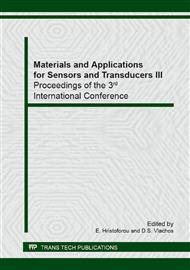p.344
p.348
p.352
p.356
p.360
p.364
p.368
p.372
p.376
Nickel Porous Electrode Pt Layered by PVD Method
Abstract:
Influence of a platinum layer on the nickel powder sintered electrode on electrochemical processes of hydrogen generation is presented and discussed in this paper. The sinters of metallic nickel with developed area were obtained by subsequent oxidation/reduction of Ni powder. The process of platinum layer deposition on surface of nickel sinters was carried out with the PVD method. The morphology characteristics of Ni and Ni-Pt layered sinters were carried out with the application of SEM/EDS method. The electrochemical properties of above mentioned sinters were examined by potentiostatic method at 40°C in 1M KOH vs. Hg|HgO, using a rotating disc electrode. It was found that the platinum layer on the surface of nickel grains was well adherent and stable. The presence of platinum on nickel sintered electrodes results in an increase of observed current density in the process of hydrogen evolution.
Info:
Periodical:
Pages:
360-363
Citation:
Online since:
April 2014
Authors:
Price:
Сopyright:
© 2014 Trans Tech Publications Ltd. All Rights Reserved
Share:
Citation:


